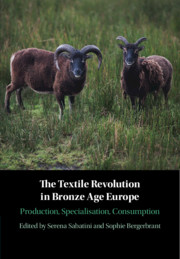Book contents
- The Textile Revolution in Bronze Age Europe
- The Textile Revolution in Bronze Age Europe
- Copyright page
- Contents
- Figures
- Tables
- Contributors
- Preface and Acknowledgements
- One Textile Production and Specialisation in Bronze Age Europe
- Two The Wool Zone in Prehistory and Protohistory
- Three Weaving in Bronze Age Italy: the Case of the Terramare settlement at Montale
- Four Loom Weights in Bronze Age Central Europe
- Five Textiles Remains in Polish Iron Age BI-RITUAL Cemeteries
- Six To Let Textiles Talk: Fibre Identification and Technological Analyses of Prehistoric Textiles from Denmark
- Seven The Challenge of Textiles in Early Bronze Age Burials: Fragments of Magnificence
- Eight Textile Ceramics as a Complement to Textile Research
- Nine Prehistoric Transhumance in the Northern Mediterranean
- Ten Wool Production and the Evidence of Strontium Isotope Analyses
- Eleven Wool Textiles in the Early Nordic Bronze Age: Local or Traded?
- Twelve Archaeological Wool Textiles: A Window into Ancient Sheep Genetics?
- Thirteen Skin, Furs, and Textiles: Mass Spectrometry-based Analysis of Ancient Protein Residues
- Fourteen Wool in the Bronze Age: Concluding Reflections
- Index
- References
Three - Weaving in Bronze Age Italy: the Case of the Terramare settlement at Montale
Published online by Cambridge University Press: 20 November 2019
- The Textile Revolution in Bronze Age Europe
- The Textile Revolution in Bronze Age Europe
- Copyright page
- Contents
- Figures
- Tables
- Contributors
- Preface and Acknowledgements
- One Textile Production and Specialisation in Bronze Age Europe
- Two The Wool Zone in Prehistory and Protohistory
- Three Weaving in Bronze Age Italy: the Case of the Terramare settlement at Montale
- Four Loom Weights in Bronze Age Central Europe
- Five Textiles Remains in Polish Iron Age BI-RITUAL Cemeteries
- Six To Let Textiles Talk: Fibre Identification and Technological Analyses of Prehistoric Textiles from Denmark
- Seven The Challenge of Textiles in Early Bronze Age Burials: Fragments of Magnificence
- Eight Textile Ceramics as a Complement to Textile Research
- Nine Prehistoric Transhumance in the Northern Mediterranean
- Ten Wool Production and the Evidence of Strontium Isotope Analyses
- Eleven Wool Textiles in the Early Nordic Bronze Age: Local or Traded?
- Twelve Archaeological Wool Textiles: A Window into Ancient Sheep Genetics?
- Thirteen Skin, Furs, and Textiles: Mass Spectrometry-based Analysis of Ancient Protein Residues
- Fourteen Wool in the Bronze Age: Concluding Reflections
- Index
- References
Summary
Adopting a community of practice model as a frame of reference, it is argued that it is possible to envision the development and patterns of specialisation within local and regional weaving practices
- Type
- Chapter
- Information
- The Textile Revolution in Bronze Age EuropeProduction, Specialisation, Consumption, pp. 39 - 79Publisher: Cambridge University PressPrint publication year: 2019

